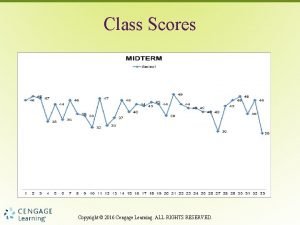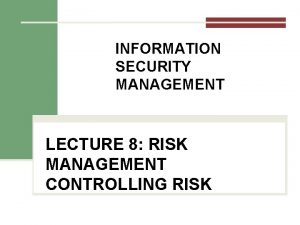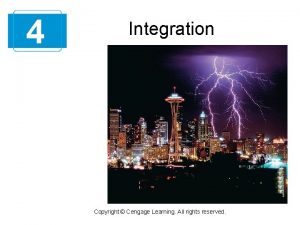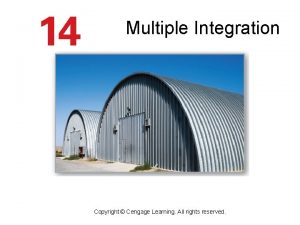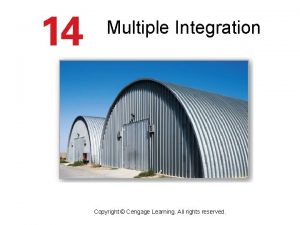P 4 Integration Copyright Cengage Learning All rights



















![Example 2 – Solution For computational convenience, define by subdividing – 2, 1] into Example 2 – Solution For computational convenience, define by subdividing – 2, 1] into](https://slidetodoc.com/presentation_image/f8ee1d627359e7f144e3d3aa6d7ccca5/image-20.jpg)






















- Slides: 42

P 4 Integration Copyright © Cengage Learning. All rights reserved.

4. 3 Riemann Sums and Definite Integrals Copyright © Cengage Learning. All rights reserved.

Objectives n Understand the definition of a Riemann sum. n Evaluate a definite integral using limits and geometric formulas. n Evaluate a definite integral using properties of definite integrals. 3

Riemann Sums 4

Example 1 – A Partition with Subintervals of Unequal Widths Consider the region bounded by the graph of and the x-axis for 0 ≤ x ≤ 1, as shown in Figure 4. 18. Evaluate the limit where ci is the right endpoint of the partition given by ci = i 2/n 2 and xi is the width of the i th interval. Figure 4. 18 5

Example 1 – Solution The width of the i th interval is So, the limit is 6

Example 1 – Solution cont’d 7

Riemann Sums We know that the region shown in Figure 4. 19 has an area of. Figure 4. 19 8

Riemann Sums Because the square bounded by 0 ≤ x ≤ 1 and 0 ≤ y ≤ 1 has an area of 1, you can conclude that the area of the region shown in Figure 4. 18 has an area of. Figure 4. 18 9

Riemann Sums This agrees with the limit found in Example 1, even though that example used a partition having subintervals of unequal widths. The reason this particular partition gave the proper area is that as n increases, the width of the largest subinterval approaches zero. This is a key feature of the development of definite integrals. 10

Riemann Sums In the definition of a Riemann sum below, note that the function f has no restrictions other than being defined on the interval [a, b]. 11

Riemann Sums The width of the largest subinterval of a partition is the norm of the partition and is denoted by || ||. If every subinterval is of equal width, the partition is regular and the norm is denoted by For a general partition, the norm is related to the number of subintervals of [a, b] in the following way. 12

Riemann Sums So, the number of subintervals in a partition approaches infinity as the norm of the partition approaches 0. That is, || ||→ 0 implies that The converse of this statement is not true. For example, let n be the partition of the interval [0, 1] given by 13

Riemann Sums As shown in Figure 4. 20, for any positive value of n, the norm of the partition n is So, letting n approach infinity does not force || || to approach 0. In a regular partition, however, the statements || ||→ 0 and are equivalent. Figure 4. 20 14

Definite Integrals 15

Definite Integrals To define the definite integral, consider the limit To say that this limit exists means there exists a real number L such that for each ε > 0 there exists a > 0 such that for every partition with || || < , it follows that regardless of the choice of ci in the i th subinterval of each partition . 16

Definite Integrals 17

Definite Integrals Though Riemann sums were defined for functions with very few restrictions, a sufficient condition for a function f to be integrable on [a, b] is that it is continuous on [a, b]. 18

Example 2 – Evaluating a Definite Integral as a Limit Evaluate the definite integral Solution: The function f(x) = 2 x is integrable on the interval [– 2, 1] because it is continuous on [– 2, 1]. Moreover, the definition of integrability implies that any partition whose norm approaches 0 can be used to determine the limit. 19
![Example 2 Solution For computational convenience define by subdividing 2 1 into Example 2 – Solution For computational convenience, define by subdividing – 2, 1] into](https://slidetodoc.com/presentation_image/f8ee1d627359e7f144e3d3aa6d7ccca5/image-20.jpg)
Example 2 – Solution For computational convenience, define by subdividing – 2, 1] into n subintervals of equal width cont’d [ Choosing ci as the right endpoint of each subinterval produces 20

Example 2 – Solution cont’d So, the definite integral is 21

Example 2 – Solution cont’d 22

Definite Integrals Because the definite integral in Example 2 is negative, it does not represent the area of the region shown in Figure 4. 21. Definite integrals can be positive, negative, or zero. For a definite integral to be interpreted as an area, the function f must be continuous and nonnegative on [a, b], as stated in the next theorem. Figure 4. 21 23

Definite Integrals Figure 4. 22 24

Definite Integrals As an example of Theorem 4. 5, consider the region bounded by the graph of f(x) = 4 x – x 2 and the x-axis, as shown in Figure 4. 23. Because f is continuous and nonnegative on the closed interval [0, 4], the area of the region is Figure 4. 23 25

Definite Integrals You can evaluate a definite integral in two ways—you can use the limit definition or you can check to see whether the definite integral represents the area of a common geometric region such as a rectangle, triangle, or semicircle. 26

Example 3 – Areas of Common Geometric Figures Sketch the region corresponding to each definite integral. Then evaluate each integral using a geometric formula. a. b. c. 27

Example 3(a) – Solution This region is a rectangle of height 4 and width 2. Figure 4. 24(a) 28

Example 3(b) – Solution cont’d This region is a trapezoid with an altitude of 3 and parallel bases of lengths 2 and 5. The formula for the area of a trapezoid is h(b 1 + b 2). Figure 4. 24(b) 29

Example 3(c) – Solution cont’d This region is a semicircle of radius 2. The formula for the area of a semicircle is Figure 4. 24(c) 30

Definite Integrals The variable of integration in a definite integral is sometimes called a dummy variable because it can be replaced by any other variable without changing the value of the integral. For instance, the definite integrals have the same value. 31

Properties of Definite Integrals 32

Properties of Definite Integrals The definition of the definite integral of f on the interval [a, b] specifies that a < b. Now, however, it is convenient to extend the definition to cover cases in which a = b or a > b. Geometrically, the next two definitions seem reasonable. For instance, it makes sense to define the area of a region of zero width and finite height to be 0. 33

Properties of Definite Integrals 34

Example 4 – Evaluating Definite Integrals Evaluate each definite integral. Solution: a. Because the sine function is defined at x = π, and the upper and lower limits of integration are equal, you can write 35

Example 4 – Solution cont’d b. The integral is the same as that given in Example 3(b) except that the upper and lower limits are interchanged. Because the integral in Example 3(b) has a value of you can write 36

Properties of Definite Integrals In Figure 4. 25, the larger region can be divided at x = c into two subregions whose intersection is a line segment. Because the line segment has zero area, it follows that the area of the larger region is equal to the sum of the areas of the two smaller regions. Figure 4. 25 37

Example 5 – Using the Additive Interval Property 38

Properties of Definite Integrals Note that Property 2 of Theorem 4. 7 can be extended to cover any finite number of functions. 39

Example 6 – Evaluation of a Definite Integral Evaluate values. using each of the following Solution: 40

Properties of Definite Integrals If f and g are continuous on the closed interval [a, b] and 0 ≤ f(x) ≤ g(x) for a ≤ x ≤ b, then the following properties are true. First, the area of the region bounded by the graph of f and the x-axis (between a and b) must be nonnegative. Second, this area must be less than or equal to the area of the region bounded by the graph of g and the x-axis (between a and b), as shown in Figure 4. 26 41

Properties of Definite Integrals These two properties are generalized in Theorem 4. 8. 42
 Cengage chapter 7
Cengage chapter 7 Copyright 2015 all rights reserved
Copyright 2015 all rights reserved Copyright © 2015 all rights reserved
Copyright © 2015 all rights reserved Dell all rights reserved copyright 2009
Dell all rights reserved copyright 2009 Copyright © 2018 all rights reserved
Copyright © 2018 all rights reserved Chapter 6:2 interpreting word parts
Chapter 6:2 interpreting word parts Chapter 5 the cardiovascular system labeling exercises
Chapter 5 the cardiovascular system labeling exercises Cengage learning heart diagram
Cengage learning heart diagram South-western cengage learning
South-western cengage learning Chapter 13 medical math
Chapter 13 medical math 2009 delmar cengage learning
2009 delmar cengage learning Cengage learning heart diagram
Cengage learning heart diagram Delmar learning medical abbreviations
Delmar learning medical abbreviations Cengage learning australia
Cengage learning australia Measuring and recording apical pulse
Measuring and recording apical pulse Cengage learning
Cengage learning Cengage learning
Cengage learning Wadsworth cengage learning
Wadsworth cengage learning Cengage learning
Cengage learning Cengage learning plant cell
Cengage learning plant cell Cengage learning
Cengage learning Cengage learning
Cengage learning Brooks cole cengage learning
Brooks cole cengage learning Pharyngorrhea
Pharyngorrhea 2014 cengage learning accounting answers
2014 cengage learning accounting answers Cengage learning
Cengage learning Cengage learning
Cengage learning Chapter 6 the skeletal system answer key
Chapter 6 the skeletal system answer key Cengage learning
Cengage learning Chapter 10 cultural diversity
Chapter 10 cultural diversity Cengage learning
Cengage learning 2012 cengage learning
2012 cengage learning Solomon four group design
Solomon four group design Cengage learning psychology
Cengage learning psychology Course technology cengage learning
Course technology cengage learning Course technology cengage learning
Course technology cengage learning Course technology cengage learning
Course technology cengage learning Course technology cengage learning
Course technology cengage learning Mgmt+8
Mgmt+8 Delmar cengage learning instructor resources
Delmar cengage learning instructor resources 2014 cengage learning
2014 cengage learning 2010 cengage learning
2010 cengage learning Positive rights vs negative rights
Positive rights vs negative rights


























